10 Indoor Flowering Plants to Brighten Your Home

One of the biggest home décor trends that has emerged post-pandemic is biophilic design, or using natural materials and elements to recreate the feel-good emotions we experience in nature in our homes.
An easy way to bring the outdoors in? Buy an indoor flowering plant from a local nursery to brighten up your home or add to your collection if you’re an avid plant parent. We’re exploring the ten most popular indoor flower plants to brighten your home and improve your mood:
1. African Violet
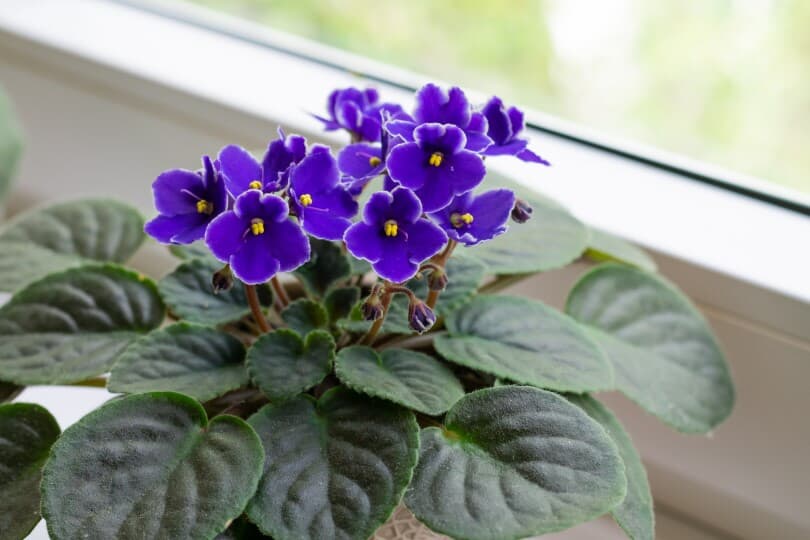
African violets are small, flowering plants popular for their bright, colorful blooms. This flower will produce deep purple or magenta blooms throughout the year if its needs are met.
Ideal Location for African Violets
African violets do best and produce the most blooms in bright, indirect light with regular house temperatures (no lower than 55F at night, nor higher than 75F during the day). Keep them at least a few feet away from bright south- or west-facing windows. An east- or north-facing window gives the best lighting without the risk of burning their sensitive foliage.
How to Care for African Violets
The soil should be moist but not soggy, as the soft stem is susceptible to rot. It’s essential to avoid getting water on the leaves, as this can cause damage and fungal spots. Use room-temperature water, as chilled water can cause marks on the leaves.
2. Orchid
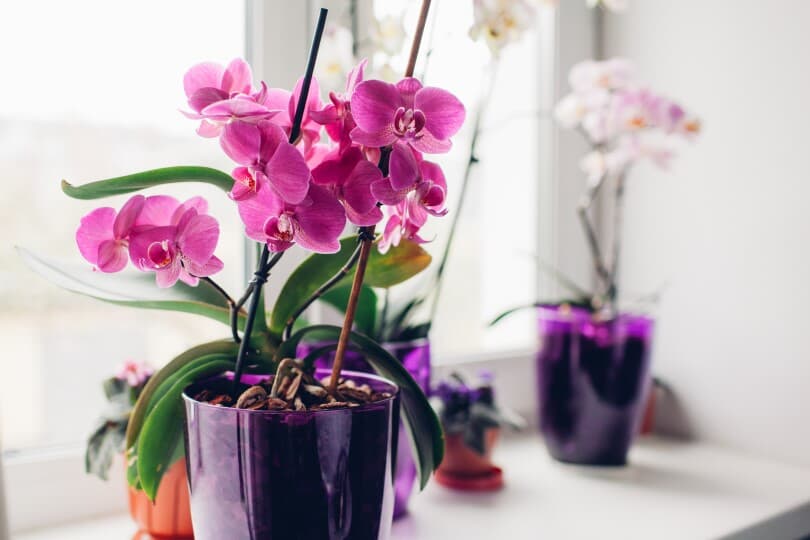
Orchids are the most popular choice for indoor plants. They are beautiful, delicate, long-blooming, long-lived, fascinating in fragrance, and highly varied.
Ideal Location for Orchids
Insufficient light is the most common reason orchids fail to bloom. They prefer bright, but indirect light from an eastern or southern window is ideal.
How to Care for Orchids
Most store-bought orchids come in plastic pots with the roots packed in soaked moss. Once you bring your home, consider repotting it, as they need air flow to avoid root rot. Orchids must have fresh, circulating air, so create gentle breezes by opening your windows in the summer and using a small fan in the winter. Water orchids just as they dry out. Don’t use ice cubes; they are tropical species and react negatively to the chill.
3. Jasmine

Jasmine is a fragrant plant that produces delicate, white flowers. Though it’s a vine usually grown outdoors, some varieties can be grown as houseplants.
Ideal Location for Jasmine
Place in a partly sunny spot to encourage growth, ideally near a south window with a trellis or similar support structure.
How to Care for Jasmine
Jasmine needs to stay cool with well-circulated air. The soil should be moist and well-drained but use care not to overwater. During the summer, let the soil completely dry between watering and water less in the fall. In the winter and spring seasons, keep the plant slightly dry.
4. Geranium

Geraniums are a longtime favorite of gardeners. With clusters of colorful flowers and lovely scents, they grow easily in containers or hanging baskets.
Ideal Location for Geraniums
Geraniums will do well in a partly sunny or sunny location where they can receive at least six to eight hours of sunshine.
How to Care for Geraniums
Geraniums thrive in a potting mix that is well drained and can dry out well in between thorough waterings. If the soil is too wet, these plants are prone to diseases such as gray mold, blossom blight, and rust. Geraniums lose and grow many leaves, so they’ll benefit from regular deadheading to encourage more blooms.
5. Begonia
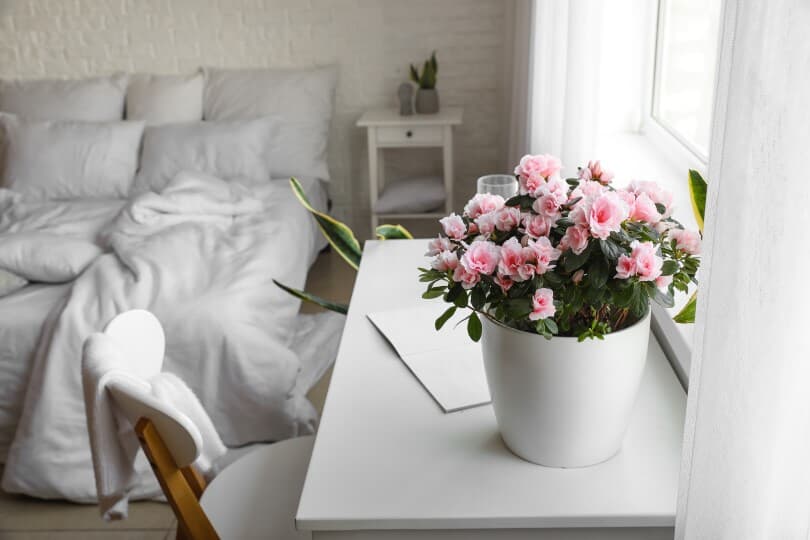
The begonia is a low-maintenance, low-light favorite that seems to thrive on neglect. Growing it requires a little bit of knowledge to keep them looking their best and producing vibrant blooms in various colors.
Ideal Location for Begonias
Place your begonia somewhere it will get bright, indirect light with plenty of humidity. If the air in your house is dry, set your plant in a shallow tray filled with pebbles and water; this will give it the necessary humidity without waterlogging the soil.
How to Care for Begonias
When you care for begonias, only water them when they show signs of being dry, like drooping leaves. This will help prevent overwatering, which is why begonias fail to thrive indoors. Water below the leaves to avoid fungus issues, like powdery mildew.
6. Peace Lily
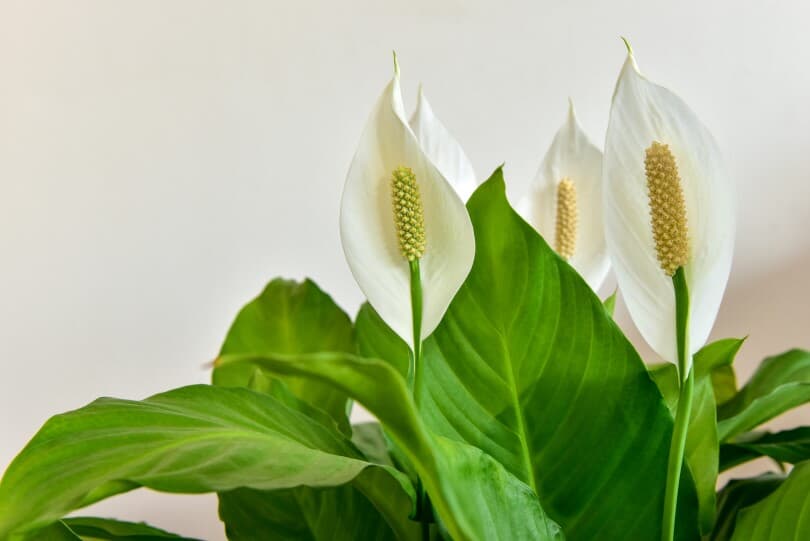
Growing peace lilies in your home brings a calm and beautiful vibe. These tropical perennials can live for years and produce their distinctive white flower over and over again.
Ideal Location for Peace Lilies
Peace lilies are easy to take care of, don’t require a lot of light, and do an excellent job of cleaning and purifying the air. If you want the flowers to bloom, place the plant where it will receive bright, indirect light. An east-facing window is ideal as it exposes the plant to the bright morning sun, but a north-facing window would also be a good choice. Avoid drafts, as this tropical plant is sensitive to cold temperatures.
How to Care for Peace Lilies
Keep the soil lightly moist to the touch but not waterlogged. Peace lilies can tolerate short periods of dry soil, but their leaves will develop brown tips if they don’t have enough water or humidity. Peace lilies are sensitive to chemicals in tap water, so it’s best to use distilled or filtered room-temperature water if possible.
7. Christmas Cactus

This winter-flowering plant is easy to care for and produces colorful blooms in vibrant red, pink, purple, or white shades. Despite having “cactus” in the name, it’s not the plant you usually think of in hot, dry desert locations. This plant is a succulent native to tropical rainforests, where they soak up the high humidity, speckled sunlight, and warm temperatures.
Ideal Location for Christmas Cacti
Place the cactus in an east-facing window or a bright bathroom for moderate light, some humidity, and direct sun. Too much direct sunlight can bleach the sensitive leaves. Christmas cacti prefer a humid environment, so they’ll do well in a bright bathroom or kitchen.
How to Care for Christmas Cacti
Plan to water every 2 to 3 weeks, but only when the top one-third of the soil feels dry to the touch. When the soil has dried out, soak until water runs through the pot’s drainage holes. Be sure to have something underneath to capture the overflow, but dump it out so the pot doesn’t sit in water.
8. Kalanchoe

Kalanchoes produce clusters of brightly colored red, pink, yellow, or white starlike flowers and are known for their low maintenance. They have incredibly long bloom periods when compared to other succulents.
Ideal Location for Kalanchoes
Kalanchoes like bright light but don’t need all-day sun, especially when blooming. To help the blossoms last longer, limit sun exposure to a half day. Use caution when deciding where to place this plant, as it is toxic to cats and dogs.
How to Care for Kalanchoes
Like many succulents, kalanchoe is a relatively hands-off species, preferring plenty of sunlight and well-draining soil. They store water in their thick waxy leaves, so it’ll be ok even if you forget to water it for a few weeks. Don’t let the pot sit in water after the soil drains, as soggy roots mean certain death.
9. Cyclamen

Cyclamen is a petite, flowering holiday plant with sweet-scented, small blooms on long stems stretching above the foliage. Flowers come in shades of pink, purple, red, and white and are often described as resembling butterflies in flight.
Ideal Location for Cyclamens
These houseplants need bright, indirect light, good air circulation, moderate humidity, and moist soil. Place cyclamens in an east- or south-facing window with indirect sunlight.
How to Care for Cyclamens
Keep the plant moist by watering when the soil looks and feels dry on the surface. Avoid watering the leaves or tubers in the center, as they may rot if the soil remains too wet. As each flower fades, remove the entire stalk from where it attaches to the tuber. New flowers will sprout from one of the many buds waiting below the foliage. Cyclamen is toxic to animals and pets, so keep this houseplant high and out of reach from small children and furry friends.
10. Anthurium

Anthuriums are also known as “flamingo flowers” or “Hawaiian love plants” for their unique tropical shape and heart-shaped blooms. Flowers come in bright red, pink, purple, lavender, hot orange, and white shades.
Ideal Location for Anthuriums
Anthuriums prefer bright but indirect light. Direct sun may cause them to dry out too much, and the leaves may develop brown, burnt tips. Keep away from children and pets, as parts of the plant can be toxic.
How to Care for Anthuriums
Keep the soil moist but not wet, allowing the top inch to dry slightly between waterings. Store the pot on a tray of damp gravel or mist it with water several times a week, as these houseplants like humid conditions.
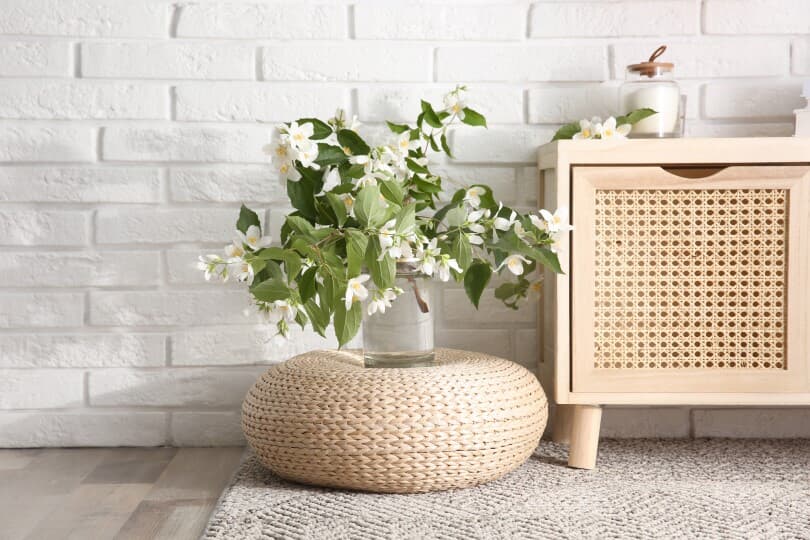
Plants in our homes improve our moods, reduce stress, and help us feel recharged. Find your favorite indoor flowering plant to add a little color to any corner of your home, and enjoy that feel-good vibe immediately.
Check out the Brookfield Residential blog for design advice, homebuying insights, mortgage tips, and more, including small space gardening ideas and how to landscape your new home. You can also explore where we build and connect with our sales team when you’re ready to learn more. We’ll be expecting you!
